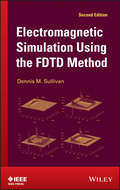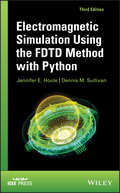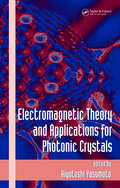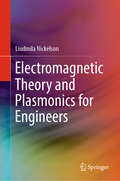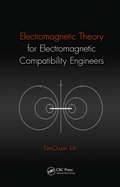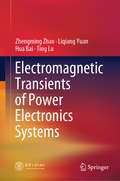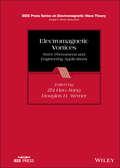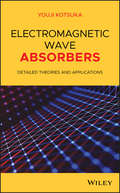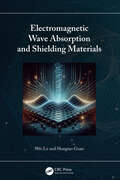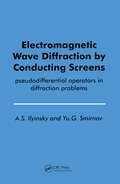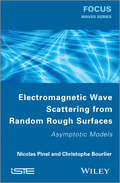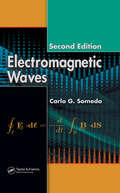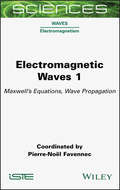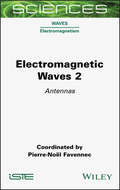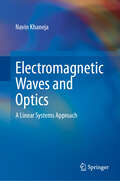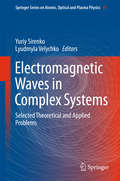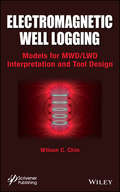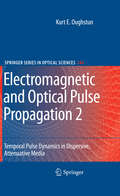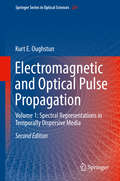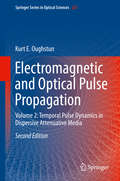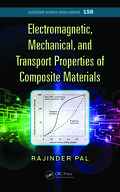- Table View
- List View
Electromagnetic Simulation Using the FDTD Method (Ieee Press Series On Rf And Microwave Technology Ser. #5)
by Dennis M. SullivanA straightforward, easy-to-read introduction to the finite-difference time-domain (FDTD) method Finite-difference time-domain (FDTD) is one of the primary computational electrodynamics modeling techniques available. Since it is a time-domain method, FDTD solutions can cover a wide frequency range with a single simulation run and treat nonlinear material properties in a natural way. Written in a tutorial fashion, starting with the simplest programs and guiding the reader up from one-dimensional to the more complex, three-dimensional programs, this book provides a simple, yet comprehensive introduction to the most widely used method for electromagnetic simulation. This fully updated edition presents many new applications, including the FDTD method being used in the design and analysis of highly resonant radio frequency (RF) coils often used for MRI. Each chapter contains a concise explanation of an essential concept and instruction on its implementation into computer code. Projects that increase in complexity are included, ranging from simulations in free space to propagation in dispersive media. Additionally, the text offers downloadable MATLAB and C programming languages from the book support site (http://booksupport.wiley.com). Simple to read and classroom-tested, Electromagnetic Simulation Using the FDTD Method is a useful reference for practicing engineers as well as undergraduate and graduate engineering students.
Electromagnetic Simulation Using the FDTD Method with Python
by Dennis M. Sullivan Jennifer E. HouleProvides an introduction to the Finite Difference Time Domain method and shows how Python code can be used to implement various simulations This book allows engineering students and practicing engineers to learn the finite-difference time-domain (FDTD) method and properly apply it toward their electromagnetic simulation projects. Each chapter contains a concise explanation of an essential concept and instruction on its implementation into computer code. Included projects increase in complexity, ranging from simulations in free space to propagation in dispersive media. This third edition utilizes the Python programming language, which is becoming the preferred computer language for the engineering and scientific community. Electromagnetic Simulation Using the FDTD Method with Python, Third Edition is written with the goal of enabling readers to learn the FDTD method in a manageable amount of time. Some basic applications of signal processing theory are explained to enhance the effectiveness of FDTD simulation. Topics covered in include one-dimensional simulation with the FDTD method, two-dimensional simulation, and three-dimensional simulation. The book also covers advanced Python features and deep regional hyperthermia treatment planning. Electromagnetic Simulation Using the FDTD Method with Python: Guides the reader from basic programs to complex, three-dimensional programs in a tutorial fashion Includes a rewritten fifth chapter that illustrates the most interesting applications in FDTD and the advanced graphics techniques of Python Covers peripheral topics pertinent to time-domain simulation, such as Z-transforms and the discrete Fourier transform Provides Python simulation programs on an accompanying website An ideal book for senior undergraduate engineering students studying FDTD, Electromagnetic Simulation Using the FDTD Method with Python will also benefit scientists and engineers interested in the subject.
Electromagnetic Theory and Applications for Photonic Crystals (Optical Science and Engineering)
by Kiyotoshi YasumotoPhotonic technology promises much faster computing, massive parallel processing, and an evolutionary step in the digital age. The search continues for devices that will enable this paradigm, and these devices will be based on photonic crystals. Modeling is a key process in developing crystals with the desired characteristics and performance, and Electromagnetic Theory and Applications for Photonic Crystals provides the electromagnetic-theoretical models that can be effectively applied to modeling photonic crystals and related optical devices.The book supplies eight self-contained chapters that detail various analytical, numerical, and computational approaches to the modeling of scattering and guiding problems. For each model, the chapter begins with a brief introduction, detailed formulations of periodic structures and photonic crystals, and practical applications to photonic crystal devices. Expert contributors discuss the scattering matrix method, multipole theory of scattering and propagation, model of layered periodic arrays for photonic crystals, the multiple multipole program, the mode-matching method for periodic metallic structures, the method of lines, the finite-difference frequency-domain technique, and the finite-difference time-domain technique.Based on original research and application efforts, Electromagnetic Theory and Applications for Photonic Crystals supplies a broad array of practical tools for analyzing and designing devices that will form the basis for a new age in computing.
Electromagnetic Theory and Plasmonics for Engineers
by Liudmila NickelsonThis book presents the theory of electromagnetic (EM) waves for upper undergraduate, graduate and PhD-level students in engineering. It focuses on physics and microwave theory based on Maxwell’s equations and the boundary conditions important for studying the operation of waveguides and resonators in a wide frequency range, namely, from approx. 10**9 to 10**16 hertz. The author also highlights various current topics in EM field theory, such as plasmonic (comprising a noble metal) waveguides and analyses of attenuations by filled waveguide dielectrics or semiconductors and also by conducting waveguide walls. Featuring a wide variety of illustrations, the book presents the calculated and schematic distributions of EM fields and currents in waveguides and resonators. Further, test questions are presented at the end of each chapter.
Electromagnetic Theory for Electromagnetic Compatibility Engineers
by Tze-Chuen TohEngineers and scientists who develop and install electronic devices and circuits need to have a solid understanding of electromagnetic theory and the electromagnetic behavior of devices and circuits. In particular, they must be well-versed in electromagnetic compatibility, which minimizes and controls the side effects of interconnected electric dev
Electromagnetic Time Reversal: Application to EMC and Power Systems
by Farhad Rachidi Marcos Rubinstein Mario PaoloneThe aim of this book is to familiarize the reader with the concept of electromagnetic time reversal, and introduce up-to-date applications of the concept found in the areas of electromagnetic compatibility and power systems. It is original in its approach to describing propagation and transient issues in power networks and power line communication, and is the result of the three main editors’ pioneering research in the area.
Electromagnetic Transients of Power Electronics Systems
by Hua Bai Zhengming Zhao Liqiang Yuan Ting LuThis book discusses topics related to power electronics, especially electromagnetic transient analysis and control of high-power electronics conversion. It focuses on the re-evaluation of power electronics, transient analysis and modeling, device-based system-safe operating area, and energy balance-based control methods, and presenting, for the first time, numerous experimental results for the transient process of various real-world converters.The book systematically presents both theoretical analysis and practical applications. The first chapter discusses the structure and attributes of power electronics systems, highlighting the analysis and synthesis, while the second chapter explores the transient process and modeling for power electronics systems. The transient features of power devices at switching-on/off, transient conversion circuit with stray parameters and device-based system-safe operating area are described in the subsequent three chapters. The book also examines the measurement of transient processes, electromagnetic pulses and their series, as well as high-performance, closed-loop control, and expounds the basic principles and method of the energy-balanced control strategy. Lastly, it introduces the applications of transient analysis of typical power electronics systems.The book is valuable as a textbook for college students, and as a reference resource for electrical engineers as well as anyone working in the field of high-power electronics system.
Electromagnetic Vibration Energy Harvesting Devices
by Dirk Spreemann Yiannos ManoliElectromagnetic vibration transducers are seen as an effective way of harvesting ambient energy for the supply of sensor monitoring systems. Different electromagnetic coupling architectures have been employed but no comprehensive comparison with respect to their output performance has been carried out up to now. Electromagnetic Vibration Energy Harvesting Devices introduces an optimization approach which is applied to determine optimal dimensions of the components (magnet, coil and back iron). Eight different commonly applied coupling architectures are investigated. The results show that correct dimensions are of great significance for maximizing the efficiency of the energy conversion. A comparison yields the architectures with the best output performance capability which should be preferably employed in applications. A prototype development is used to demonstrate how the optimization calculations can be integrated into the design-flow. Electromagnetic Vibration Energy Harvesting Devices targets the designer of electromagnetic vibration transducers who wishes to have a greater in-depth understanding for maximizing the output performance.
Electromagnetic Vortices: Wave Phenomena and Engineering Applications (IEEE Press Series on Electromagnetic Wave Theory)
by Zhi Hao Jiang Douglas H. WernerDiscover the most recent advances in electromagnetic vortices In Electromagnetic Vortices: Wave Phenomena and Engineering Applications, a team of distinguished researchers delivers a cutting-edge treatment of the research and development of electromagnetic vortex waves, including their related wave properties and several potentially transformative applications. The book is divided into three parts. The editors first include resources that describe the generation, sorting, and manipulation of vortex waves, as well as descriptions of interesting wave behavior in the infrared and optical regimes with custom-designed nanostructures. They then discuss the generation, multiplexing, and propagation of vortex waves at the microwave and millimeter-wave frequencies. Finally, the selected contributions discuss several representative practical applications of vortex waves from a system perspective. With coverage that incorporates demonstration examples from a wide range of related sub-areas, this essential edited volume also offers: Thorough introductions to the generation of optical vortex beams and transformation optical vortex wave synthesizers Comprehensive explorations of millimeter-wave metasurfaces for high-capacity and broadband generation of vector vortex beams, as well as OAM detection and its observation in second harmonic generations Practical discussions of microwave SPP circuits and coding metasurfaces for vortex beam generation and orbital angular momentum-based structured radio beams and their applications In-depth examinations of OAM multiplexing using microwave circuits for near-field communications and wireless power transmission Perfect for students of wireless communications, antenna/RF design, optical communications, and nanophotonics, Electromagnetic Vortices: Wave Phenomena and Engineering Applications is also an indispensable resource for researchers at large defense contractors and government labs.
Electromagnetic Wave Absorbers: Detailed Theories and Applications
by Youji KotsukaAddresses the importance of EM wave absorbers and details pertinent theory, design, and applications Demands for various EM-wave absorbers are rapidly increasing along with recent trends toward complicated electromagnetic environments and development of higher-frequency communication equipment, including AI technology. This book provides a broad perspective on electromagnetic wave absorbers, as well as discussion of specific types of absorbers, their advantages and disadvantages, their applications, and performance verification. Electromagnetic Wave Absorbers: Detailed Theories and Applications presents the theory behind wave absorbers and their practical usage in design of EM-wave absorber necessary particularly for EMC environments, and similar applications. The first half of the book contains the foundations of electromagnetic wave engineering, specifically the transmission line theories necessary for EM-wave absorber analysis, the basic knowledge of reflection, transmission, and absorption of electromagnetic waves, derivation of Maxwell's equations and computer analysis. The second half describes special mediums, absorber application examples, simplified methods of absorber design, autonomously controllable EM-wave absorber, and more. This valuable text: Provides detailed explanations of basic theory and applied theory for understanding EM-wave absorbers Discusses the material constant measurement methods of EM-wave absorption characteristics that are necessary for designing EM-wave absorbers Includes examples of novel EM-wave absorber configurations Electromagnetic Wave Absorbers: Detailed Theories and Applications is an ideal read for researchers and students concerned with electromagnetic wave engineering. It will also appeal to computer software engineers and electromagnetic field theory researchers.
Electromagnetic Wave Absorption and Shielding Materials
by Wei Lu Hongtao GuanThis book reveals the latest research findings and innovations in electromagnetic wave absorption and shielding by exploring the design and application of absorbent materials, the optimization of shielding structures and the improvement of testing and evaluation methods.From conductive materials to magnetic materials, and composite materials to nanomaterials, Electromagnetic Wave Absorption and Shielding Materials details the characteristics and advantages of various absorbent materials and explains their applications in electromagnetic wave absorption and shielding. It then introduces the different methods of electromagnetic shielding, including structural shielding and material shielding. The book also studies experimental and testing techniques, including measurement methods and evaluation criteria for electromagnetic wave absorption performance.The book will be of interest to researchers and graduate students in electromagnetic compatibility, materials science and engineering.
Electromagnetic Wave Diffraction by Conducting Screens pseudodifferential operators in diffraction problems
by Yu. G. SmirnovThis book covers the latest problems of modern mathematical methods for three-dimensional problems of diffraction by arbitrary conducting screens. This comprehensive study provides an introduction to methods of constructing generalized solutions, elements of potential theory, and other underlying mathematical tools. The problem settings, which turn out to be extremely effective, differ significantly from the known approaches and are based on the original concept of vector spaces 'produced' by Maxwell equations. The formalism of pseudodifferential operators enables to prove uniqueness theorems and the Fredholm property for all problems studied. Readers will gain essential insight into the state-of-the-art technique of investigating three-dimensional problems for closed and unclosed screens based on systems of pseudodifferential equations. A detailed treatment of the properties of their kernels, in particular degenerated, is included. Special attention is given to the study of smoothness of generalized solutions and properties of traces.
Electromagnetic Wave Propagation, Radiation, and Scattering: From Fundamentals to Applications (Second Edition)
by Akira IshimaruPresented in two parts, this book takes an analytical approach on the subject and emphasizes new ideas and applications used today. Part one covers fundamentals of electromagnetic wave propagation, radiation, and scattering. It provides ample end-of-chapter problems and offers a 90-page solution manual to help readers check and comprehend their work. The second part of the book explores up-to-date applications of electromagnetic waves—including radiometry, geophysical remote sensing and imaging, and biomedical and signal processing applications. Written by a world renowned authority in the field of electromagnetic research, this new edition of Electromagnetic Wave Propagation, Radiation, and Scattering: From Fundamentals to Applications presents detailed applications with useful appendices, including mathematical formulas, Airy function, Abel’s equation, Hilbert transform, and Riemann surfaces. Primarily a textbook for graduate courses in electrical engineering, Electromagnetic Wave Propagation, Radiation, and Scattering is also ideal for graduate students in bioengineering, geophysics, ocean engineering, and geophysical remote sensing. The book is also a useful reference for engineers and scientists working in fields such as geophysical remote sensing, bio–medical engineering in optics and ultrasound, and new materials and integration with signal processing.
Electromagnetic Wave Scattering from Random Rough Surfaces: Asymptotic Models
by Christophe Boulier Nicolas PinelElectromagnetic wave scattering from random rough surfaces is an active, interdisciplinary area of research with myriad practical applications in fields such as optics, acoustics, geoscience and remote sensing. Focusing on the case of random rough surfaces, this book presents classical asymptotic models used to describe electromagnetic wave scattering. The authors begin by outlining the basic concepts relevant to the topic before moving on to look at the derivation of the scattered field under asymptotic models, based on the Kirchhoff-tangent plane, in order to calculate both the scattered field and the statistical average intensity. More elaborated asymptotic models are also described for dealing with specific cases, and numerical results are presented to illustrate these models. Comparisons with a reference numerical method are made to confirm and refine the theoretical validity domains. The final chapter derives the expressions of the scattering intensities of random rough surfaces under the asymptotic models. Its expressions are given for their incoherent contributions, from statistical calculations. These results are then compared with numerical computations using a Monte-Carlo process, as well as with experimental models, for sea surface backscattering. Contents 1. Electromagnetic Wave Scattering from Random Rough Surfaces: Basics. 2. Derivation of the Scattered Field under Asymptotic Models. 3. Derivation of the Normalized Radar Cross-Section under Asymptotic Models. APPENDIX 1. Far-Field Scattered Fields under the Method of Stationary Phase. APPENDIX 2. Calculation of the Scattering Coefficients under the GO for 3D Problems. About the Authors Nicolas Pinel worked as a Research Engineer at the IETR (Institut d’Electronique et de Télécommunications de Rennes) laboratory at Polytech Nantes (University of Nantes, France) before joining Alyotech Technologies in Rennes, France, in July 2013. His research interests are in the areas of radar and optical remote sensing, scattering and propagation. In particular, he works on asymptotic methods of electromagnetic wave scattering from random rough surfaces and layers. Christophe Bourlier works at the IETR (Institut d’Electronique et de Télécommunications de Rennes) laboratory at Polytech Nantes (University of Nantes, France) and is also a Researcher at the French National Center for Scientific Research (CNRS) on electromagnetic wave scattering from rough surfaces and objects for remote sensing applications and radar signatures. He is the author of more than 160 journal articles and conference papers.
Electromagnetic Wave Scattering on Nonspherical Particles
by Tom Rother Michael KahnertThis book gives a detailed overview of the theory of electromagnetic wave scattering on single, homogeneous, but nonspherical particles. Beside the systematically developed Green's function formalism of the first edition this second and enlarged edition contains additional material regarding group theoretical considerations for nonspherical particles with boundary symmetries, an iterative T-matrix scheme for approximate solutions, and two additional but basic applications. Moreover, to demonstrate the advantages of the group theoretical approach and the iterative solution technique, the restriction to axisymmetric scatterers of the first edition was abandoned.
Electromagnetic Waves (Second Edition)
by Carlo G. SomedaAdapted from a successful and thoroughly field-tested Italian text, the first edition of Electromagnetic Waves was very well received. Its broad, integrated coverage of electromagnetic waves and their applications forms the cornerstone on which the author based this second edition. <P><P>Working from Maxwell's equations to applications in optical communications and photonics, Electromagnetic Waves, Second Edition forges a link between basic physics and real-life problems in wave propagation and radiation. <P><P>Accomplished researcher and educator Carlo G. Someda uses a modern approach to the subject. Unlike other books in the field, it surveys all major areas of electromagnetic waves in a single treatment. <P><P>The book begins with a detailed treatment of the mathematics of Maxwell's equations. It follows with a discussion of polarization, delves into propagation in various media, devotes four chapters to guided propagation, links the concepts to practical applications, and concludes with radiation, diffraction, coherence, and radiation statistics. <P><P>This edition features many new and reworked problems, updated references and suggestions for further reading, a completely revised appendix on Bessel functions, and new definitions such as antenna effective height. <P><P>Illustrating the concepts with examples in every chapter, Electromagnetic Waves, Second Edition is an ideal introduction for those new to the field as well as a convenient reference for seasoned professionals.
Electromagnetic Waves 1: Maxwell's Equations, Wave Propagation
by Pierre-Noël FavennecElectromagnetic Waves 1 examines Maxwell’s equations and wave propagation. It presents the scientific bases necessary for any application using electromagnetic fields, and analyzes Maxwell’s equations, their meaning and their resolution for various situations and material environments. These equations are essential for understanding electromagnetism and its derived fields, such as radioelectricity, photonics, geolocation, measurement, telecommunications, medical imaging and radio astronomy. This book also deals with the propagation of electromagnetic, radio and optical waves, and analyzes the complex factors that must be taken into account in order to understand the problems of propagation in a free and confined space. Electromagnetic Waves 1 is a collaborative work, completed only with the invaluable contributions of Ibrahima Sakho, Hervé Sizun and JeanPierre Blot, not to mention the editor, Pierre-Noël Favennec. Aimed at students and engineers, this book provides essential theoretical support for the design and deployment of wireless radio and optical communication systems.
Electromagnetic Waves 2: Antennas
by Pierre-Noël FavennecElectromagnetic Waves 2 examines antennas in the field of radio waves. It analyzes the conditions of use and the parameters that are necessary in order to create an effective antenna. This book presents antennas’ definitions, regulations and fundamental equations, and describes the various forms of antennas that can be used in radio: horns, waveguides, coaxial cables, printed and miniature antennas. It presents the characterization methods and the link budgets as well as the digital methods that make the fine calculation of radio antennas possible. Electromagnetic Waves 2 is a collaborative work, completed only with the invaluable contributions of Ibrahima Sakho, Hervé Sizun and JeanPierre Blot, not to mention the editor, Pierre-Noël Favennec. Aimed at students and engineers, this book provides essential theoretical support for the design and deployment of wireless radio and optical communication systems.
Electromagnetic Waves and Optics: A Linear Systems Approach
by Navin KhanejaThe book explores electromagnetic (EM) waves, which are present everywhere—from radio, television, and cell phones to satellite dishes, antennas, and WiFi. The propagation of EM waves is governed by Maxwell's equations. When these waves pass through a medium, they slow down and refract, while in a metallic medium, they are reflected. Metallic boxes and pipes can store and direct EM waves, known as cavities and waveguides. Oscillating currents generate and transmit EM waves through antennas, allowing for long-distance communication after the waves propagate. Since oscillating currents emit EM waves, the author uses coaxial cables and transmission lines to reduce radiation and carry high-frequency currents efficiently. EM waves at very high frequencies in the optical range are responsible for transmitting visual information. The author also discusses lenses and optical instruments like telescopes and microscopes, which are used to magnify optical signals. Additionally, the quantum mechanical origins of a material’s permittivity, which affects the speed of light through the medium, are examined.
Electromagnetic Waves in Complex Systems
by Yuriy Sirenko Lyudmyla VelychkoThis book gives guidance to solve problems in electromagnetics, providing both examples of solving serious research problems as well as the original results to encourage further investigations. The book contains seven chapters on various aspects of resonant wave scattering, each solving one original problem. All of them are unified by the authors' desire to show advantages of rigorous approaches at all stages, from the formulation of a problem and the selection of a method to the interpretation of results. The book reveals a range of problems associated with wave propagation and scattering in natural and artificial environments or with the design of antennas elements. The authors invoke both theoretical (analytical and numerical) and experimental techniques for handling the problems. Attention is given to mathematical simulations, computational efficiency, and physical interpretation of the experimental results. The book is written for students, graduate students and young researchers.
Electromagnetic Well Logging
by Wilson C. ChinAlmost all publications on borehole electromagnetics deal with idealizations that are not acceptable physically, and unfortunately, even these models are company proprietary. On the other hand, "exact models" are only available through detailed finite element or finite difference analysis, and more often than not, simply describe case studies for special applications. In either case, the models are not available for general use and the value of the publications is questionable. This new approach provides a rigorous, fully three-dimensional solution to the general problem, developed over almost two decades by a researcher familiar with practical applications and mathematical modeling. Completely validated against exact solutions and physics-based checks through over a hundred documented examples, the self-contained model (with special built-in matrix solvers and iteration algorithms) with a "plain English graphical user interface" has been optimized to run extremely fast - seconds per run as opposed to minutes and hours - and then automatically presents all electric and magnetic field results through integrated three-dimensional color graphics. In addition to state-of-the-art algorithms, basic "utility programs" are also developed, such as simple dipole methods, Biot-Savart large diameter models, nonlinear phase and amplitude interpolation algorithms, and so on. Incredibly useful to oilfield practitioners, this volume is a must-have for serious professionals in the field, and all the algorithms have undergone a laborious validation process with real use in the field.
Electromagnetic and Optical Pulse Propagation 2
by Kurt E. OughstunElectromagnetic & Optical Pulse Propagation presents a detailed, systematic treatment of the time-domain electromagnetics with application to the propagation of transient electromagnetic fields (including ultrawideband signals and ultrashort pulses) in homogeneous, isotropic media which exhibit both temporal frequency dispersion and attenuation. The development is mathematically rigorous with strict adherence to the fundamental physical principle of causality. Approximation methods are based upon mathematically well-defined asymptotic techniques that are based upon the saddle point method. A detailed description is given of the asymptotic expansions used. Meaningful exercises are given throughout the text to help the reader's understanding of the material, making the book a useful graduate level text in electromagnetic wave theory for both physics, electrical engineering and materials science programs. Both students and researchers alike will obtain a better understanding of time domain electromagnetics as it applies to electromagnetic radiation and wave propagation theory with applications to ground and foliage penetrating radar, medical imaging, communications, and the health and safety issues associated with ultrawideband pulsed fields. Volume 2 presents a detailed asymptotic description of plane wave pulse propagation in dielectric, conducting, and semiconducting materials as described by the classical Lorentz model of dielectric resonance, the Rocard-Powles-Debys model of orientational polarization, and the Drude model of metals. The rigorous description of the signal velocity of a pulse in a dispersive material is presented in connection with the question of superluminal pulse propagation.
Electromagnetic and Optical Pulse Propagation: Volume 1: Spectral Representations in Temporally Dispersive Media (Springer Series in Optical Sciences #224)
by Kurt E. OughstunThis volume presents a detailed, rigorous treatment of the fundamental theory of electromagnetic pulse propagation in causally dispersive media that is applicable to dielectric, conducting, and semiconducting media. Asymptotic methods of approximation based upon saddle point methods are presented in detail.
Electromagnetic and Optical Pulse Propagation: Volume 2: Temporal Pulse Dynamics in Dispersive Attenuative Media (Springer Series in Optical Sciences #225)
by Kurt E. OughstunIn two volumes, this book presents a detailed, systematic treatment of electromagnetics with application to the propagation of transient electromagnetic fields (including ultrawideband signals and ultrashort pulses) in dispersive attenuative media. The development in this expanded, updated, and reorganized new edition is mathematically rigorous, progressing from classical theory to the asymptotic description of pulsed wave fields in Debye and Lorentz model dielectrics, Drude model conductors, and composite model semiconductors. It will be of use to researchers as a resource on electromagnetic radiation and wave propagation theory with applications to ground and foliage penetrating radar, medical imaging, communications, and safety issues associated with ultrawideband pulsed fields. With meaningful exercises, and an authoritative selection of topics, it can also be used as a textbook to prepare graduate students for research. Volume 2 presents a detailed asymptotic description of plane wave pulse propagation in dielectric, conducting, and semiconducting materials as described by the classical Lorentz model of dielectric resonance, the Rocard-Powles-Debye model of orientational polarization, and the Drude model of metals. The rigorous description of the signal velocity of a pulse in a dispersive material is presented in connection with the question of superluminal pulse propagation. The second edition contains new material on the effects of spatial dispersion on precursor formation, and pulse transmission into a dispersive half space and into multilayered media. Volume 1 covers spectral representations in temporally dispersive media.
Electromagnetic, Mechanical, and Transport Properties of Composite Materials (Surfactant Science)
by Rajinder PalIn the design, processing, and applications of composite materials, a thorough understanding of the physical properties is required. It is important to be able to predict the variations of these properties with the kind, shape, and concentration of filler materials. The currently available books on composite materials often emphasize mechanical pro
